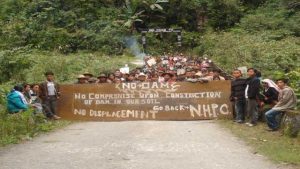On February 28, the Indian government approved the construction of a hydropower project across the River Dibang in the Northeast Indian state of Arunachal Pradesh. The $3.9 billion project is India’s largest-ever hydropower project and at a height of 278 meters, the dam will be the tallest concrete gravity dam in the world.
Located in the Lower Dibang Valley, the Dibang Multipurpose Project (DMP) “is envisaged as a storage-based hydroelectric project with flood moderation as the key objective.”
It will generate 2,880 MW of electricity. This will be a “valuable contribution to India’s efforts to transition from coal to clean energy,” an official of the National Hydro Power Corporation, which is implementing the project, told The Diplomat.
Arunachal Pradesh will receive 12 percent free power from the project over its life span of 40 years, in addition to another 1 percent under the Local Area Development Fund. The state will also earn from the sale of surplus electricity to other states.
Besides, the DMP is expected to help “moderate the flow of water” into the River Brahmaputra and prevent the annual flooding of the Northeast, the NHPC official said.
The Dibang River, which originates on the Indian side of the disputed India-China border in Arunachal Pradesh, is a tributary of the Brahmaputra, which originates in Tibet. After traversing 1,700 km in Tibet, where it is known as the Yarlung Tsangpo, the Brahmaputra flows for 920 km through the states of Arunachal Pradesh and Assam in India, and for 260 km in Bangladesh before emptying its waters into the Bay of Bengal.
The Brahmaputra accounts for nearly 30 percent of India’s freshwater sources and 40 percent of its hydropower potential. With China constructing dams at several points across the Yarlung Tsangpo – one of these dams will be located at the “Great Bend” where the river makes a spectacular U-turn before entering India, India has plans to construct several dams on the Brahmaputra in Arunachal Pradesh.
Indian officials have linked the building of storage dams on international rivers to establishing “rights over that quantum of water as a riparian state.” Reports in the Indian media suggest that the DMP is also aimed at strengthening India’s user rights in the Brahmaputra river system.
However, there may be more to India’s dam-building spree in Arunachal Pradesh than power generation, prevention of floods and establishing user rights.
Pointing out that “India already has user rights as a lower riparian on the transboundary [Brahmaputra] river,” Satu Limaye, president and director, East West Center in Washington, argues in his chapter in the book “Raging Waters: China, India, Bangladesh, and Brahmaputra River Politics,” which he co-authored with Nilanthi Samaranayake and Joel Wuthnow, that it is “more likely” that India’s dam building activity on the Brahmaputra is aimed at “consolidating India’s rights to the territory where the transboundary Brahmaputra flows rather than to the waters of the river per se.“
The Brahmaputra and several of its tributaries like the Dibang run through or originate in Arunachal Pradesh, where China claims around 90,000 sq km of territory.
In addition to dams, India is building roads, bridges and tunnels in this border state. While such infrastructure is being developed to facilitate faster mobilization of Indian troops and weaponry to the disputed India-China border, it also serves India’s objective of asserting control over the region.
India’s construction of the DMP and other hydropower projects may bring it multiple benefits, but these come at a heavy cost.
The DMP is expected to displace thousands of people, inundate some 11,624 acres of forest and threaten wildlife, including endangered and critically endangered animals. The project is expected to severely impact the tiny Idu Mishmi tribal group. They would be displaced and separated from the mountains, forests and wildlife that shape their lives, livelihood and unique identity. They have been at the forefront of the resistance to the DMP.
Additionally, the project is situated in a highly seismic zone. Earthquakes in the region have been “catastrophic,” warns geographer Chintan Sheth.
There is concern in Bangladesh, the lower riparian country, that the damming of the Brahmaputra will reduce water flow into the country.
Besides, “upstream dam activities can have downstream consequences,” Nilanthi Samaranayake, director of the Strategy and Policy Analysis Program at CNA, a nonprofit research organization in the Washington area, told The Diplomat. “For example, uncertainty over sedimentation and food security outcomes raises anxiety for both India and Bangladesh. In particular, there are concerns in Bangladesh, as the lowest riparian, about water quality impacts,” she said.
There is concern in downstream Assam that debris from upstream construction activity and landslides will “elevate riverbeds.” Contrary to claims that the DMP will prevent floods, the damming of the Brahmaputra could make downstream areas in Assam and Bangladesh more vulnerable to flooding.
The foundation stone for the DMP was laid back in 2008. The project ran into trouble thereafter as it came under strong resistance from local communities, seismologists and environmentalists in Arunachal Pradesh, Assam and other parts of India. The protests forced the government to put the project on hold.
However, proponents of the DMP, including ministers and officials in New Delhi and Arunachal Pradesh as well as India’s powerful big dam lobby, systematically chipped at the resistance to the project. The consent of tribal protestors was “manufactured” through terrorizing them; they were branded ‘Maoist’ and their resistance was broken. The government has steamrolled objections and issues of concern raised by activists and experts to give the DMP the green signal.
Whether the decision will reignite protests remains to be seen.

































